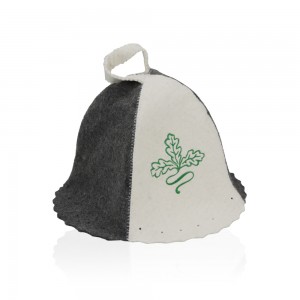The latest clothes that everyone is wearing, made of felt wool, often pointy and not very pretty, come not from the catwalks or celebrities, but from the wintry wilderness of Scandinavia.
With independent saunas becoming increasingly popular (the British Sauna Association says there are now 147 high-quality, authentic saunas in the UK that are bookable for anyone to use), sauna caps have become a popular topic on British social media, selling out online and being worn by sauna lovers across the country. Indoor shots also show them strategically placed in the sauna, showcasing the wearer’s healthy lifestyle and showing that they can tell the difference between a hot sauna and a cold one. Some have even dubbed it the ‘dry suit’ of 2025.
It’s January, a time for resolutions, and no matter what you look like when you put it on, the point is that a sauna hat is (pardon the pun) all about how it makes you feel. Or, perhaps more importantly, how it doesn’t make you feel. It may seem counterintuitive, but according to Finnish personal sauna expert Finnmark, wearing this fleece hat in the sauna can actually reduce the impact of the sauna’s heat on your head and ears.
Regular “heat therapy” has been shown to have many health benefits, including improved cardiovascular and bone health, increased metabolism, prevention of Alzheimer’s disease, improved sleep, and reduced stress. However, many sauna newbies find the burning pain from the high temperatures unpleasant, especially in the scalp.
This is where a sauna hat comes in. Proponents of sauna hats claim that the product has a host of undeniable benefits, from regulating body temperature to reducing the risk of dizziness in the heat, reducing sweating and preventing baldness.
Of course, hot boxes are nothing new. The earliest forms of saunas date back 10,000 years, and the same can be said for sauna hats; similar models, originally made of straw, have been worn for thousands of years in Russia, Eastern Europe, and Germanic countries.
Marjo Karhu of Finnmark Sauna says sauna hats (from £4.99) have been selling like hotcakes on the brand’s website over the past year, especially as British sauna lovers have started to embrace the centuries-old Scandinavian tradition. “Finnmark makes bespoke saunas, and although sauna hats are only a small part of our business, it has definitely grown significantly over the past year,” says Karhu, who grew up in Finland. “This is obviously due to the rapid rise of saunas in British culture. The more people see saunas on beaches or in unusual places, the more people see sauna hats, which has piqued people’s curiosity.”
According to the brand, sauna hats are popular because they create an insulating barrier between your head and the heat, allowing you to enjoy “löyly” (the Finnish word for the steam rising from the sauna stove over the hot stones) without discomfort. “Especially when you’re sitting on the upper benches near the ceiling, where the sauna is at its hottest,” adds Karhu. “In these conditions, some people may find that their head is unbearably hot, even if the rest of their body feels fine, and that’s where a sauna cap comes in handy. Protecting the scalp, ears, and hair from overheating means users can enjoy the wellness benefits of the sauna for longer.”
High temperatures can be harmful to hair, especially color-treated or chemically treated hair, but there are also reports that high temperatures are beneficial. “A properly fitted felt sauna cap can protect your hair from the heat,” says Karhu. “It has also been suggested that protecting your scalp from the heat in a sauna can help prevent hair loss.”
Sauna hats are traditionally made of wool felt (alpaca and sheepskin are both good choices), a material that is naturally antibacterial and repels dirt and moisture, as well as wicks away moisture. They can be worn in the sauna, under a cold shower after a traditional warm-up, or in a hot tub. Although purists recommend using a dry sauna cap, you can also soak it in cold water and wring it out before entering the sauna (but keep in mind that a wet sauna cap will heat up, so you’ll need to occasionally wet it with cold water during your sauna to maintain the cooling effect).
Almost any hood will do (another popular material for sauna hoods is natural linen, which is moisture-wicking and skin-friendly), but synthetics should be avoided, and models that fit tightly at the crown of the head will not provide the same cooling effect as higher, more breathable models.
Sarah, of Seaside Sauna Haus in West Town Beach, Dorset, is a fan. “The dark grey one is one I made myself,” she said. “The thicker the wool, the warmer it is. Pure wool is best.”
The best thing about sauna hats, however, is that they are inexpensive and require little maintenance – just hang them up to dry or rinse them in clean cold water after use and hang them up to dry. This is not the case with most fashion trends.
Explore award-winning British journalism and broaden your horizons. Try The Daily Telegraph free for 1 month and get unlimited access to our award-winning website, exclusive apps, great deals and more.

Post time: Apr-18-2025
